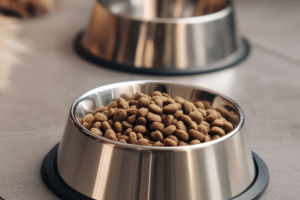Feeding our pets isn't just about filling their bowls—it's about giving them the nutrients they need to stay healthy, active, and happy.
With shelves full of options and marketing claims, it's easy to feel overwhelmed. But if we take the time to understand what matters, we can confidently choose what's best for our furry companions.
Step 1: Know Your Pet's Basic Needs
Not all pets need the same type of food. Age, size, breed, and activity level all play a role. For example:
• Puppies or kittens need food with higher calories and nutrients for growth.
• Adult pets need a balanced diet to maintain weight and health.
• Senior pets may need food that's easier to digest or lower in calories.
Also, indoor pets may need fewer calories than those who run and play outside all day. Knowing our pet's current life stage helps us narrow down the options right away.
Step 2: Understand the Ingredients List
Ingredients are listed in order of quantity. So if we see real meat or fish (like "chicken" or "salmon") listed first, that's usually a good sign. Be cautious with vague terms like "meat meal" or "animal by-products" as the quality can vary.
Here's what to look for:
• A clear protein source as the first ingredient
• Whole grains or vegetables for fiber
• No unnecessary fillers like corn, wheat, or artificial dyes
• Added vitamins and minerals for full nutrition
The simpler and more recognizable the ingredients, the easier it is to trust what we're feeding our pets.
Step 3: Match Food to Health Conditions
Just like us, pets can have health needs too. Some common ones include:
• Sensitive stomachs: Look for limited-ingredient or easily digestible formulas.
• Allergies or intolerances: Grain-free or single-protein foods might help.
• Joint issues or aging: Choose food with glucosamine and omega-3s.
• Weight management: Low-calorie or high-fiber options can support a healthy weight.
When in doubt, we can ask the vet for guidance—especially if our pet is already on medication or has a medical condition.
Step 4: Dry Food, Wet Food, or Both?
Each type of food has its pros and cons:
• Dry food (kibble): Easy to store, often more affordable, and can help keep teeth cleaner.
• Wet food (canned): Higher moisture content, more flavorful, and easier for picky eaters or older pets.
• Mixing both: Gives variety and hydration while keeping costs manageable.
The best option depends on our pet's needs—and sometimes their personality! Some pets love crunchy food, while others prefer soft textures.
Step 5: Pay Attention to Portion and Schedule
Even healthy food can lead to problems if we overfeed. Check the feeding guide on the packaging, and adjust based on our pet's energy level and weight. We can use a measuring cup to keep portions accurate.
Also, sticking to a regular feeding routine—same time every day—helps our pets feel secure and prevents overeating.
Step 6: Watch for Reactions
After switching foods or trying something new, we should observe how our pet reacts. Signs to watch out for include:
• Digestive issues like vomiting or loose stool
• Changes in energy or mood
• Excessive scratching or skin changes
• Sudden weight gain or loss
If anything seems off, it's okay to switch back or consult with a vet.
Let's Chat, Lykkers!
What's your pet's favorite food? Have you ever had a hard time picking the right one? Share your experience—we're all learning how to keep our furry family members healthy and happy.
Feeding our pets well is one of the best ways to show love. With the right knowledge, we can make every mealtime a nourishing one. Let's take it step by step—and make sure our pets thrive. 🐾


